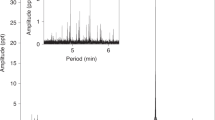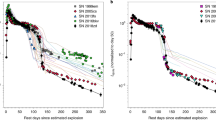Abstract
Type Ia supernovae are thought to occur when a white dwarf made of carbon and oxygen accretes sufficient mass to trigger a thermonuclear explosion1. The accretion could be slow, from an unevolved (main-sequence) or evolved (subgiant or giant) star2,3 (the single-degenerate channel), or rapid, as the primary star breaks up a smaller orbiting white dwarf3,4 (the double-degenerate channel). A companion star will survive the explosion only in the single-degenerate channel5. Both channels might contribute to the production of type Ia supernovae6,7, but the relative proportions of their contributions remain a fundamental puzzle in astronomy. Previous searches for remnant companions have revealed one possible case for SN 1572 (refs 8, 9), although that has been questioned10. More recently, observations have restricted surviving companions to be small, main-sequence stars11,12,13, ruling out giant companions but still allowing the single-degenerate channel. Here we report the results of a search for surviving companions of the progenitor of SN 1006 (ref. 14). None of the stars within 4 arc minutes of the apparent site of the explosion is associated with the supernova remnant, and we can firmly exclude all giant and subgiant stars from being companions of the progenitor. In combination with previous results, our findings indicate that fewer than 20 per cent of type Ia supernovae occur through the single-degenerate channel.
This is a preview of subscription content, access via your institution
Access options
Subscribe to this journal
Receive 51 print issues and online access
$199.00 per year
only $3.90 per issue
Buy this article
- Purchase on SpringerLink
- Instant access to full article PDF
Prices may be subject to local taxes which are calculated during checkout



Similar content being viewed by others
References
Nomoto, K., Saio, H., Kato, M. & Hachisu, I. Thermal stability of white dwarfs accreting hydrogen-rich matter and progenitors of type Ia supernovae. Astrophys. J. 663, 1269–1276 (2007)
Whelan, J. & Iben, I., Jr Binaries and supernovae of type 1. Astrophys. J. 186, 1007–1014 (1973)
Branch, D., Livio, M., Yungelson, L. R., Boffi, F. & Baron, E. In search of the progenitors of type Ia supernovae. Publ. Astron. Soc. Pacif. 107, 1019–1029 (1995)
Pakmor, R. et al. Sub-luminous type Ia supernovae from the mergers of equal-mass white dwarfs with mass 0.9 . Nature 463, 61–64 (2010)
Ruiz-Lapuente, P. The quest for a supernova companion. Science 276, 1813–1814 (1997)
Greggio, L. The rates of Type Ia supernovae – II. Diversity of events at low and high redshifts. Mon. Not. R. Astron. Soc. 406, 22–42 (2010)
Brandt, T. D. et al. The ages of type Ia supernova progenitors. Astrophys. J. 140, 804–816 (2010)
Ruiz-Lapuente, P. et al. The binary progenitor of Tycho Brahe’s 1572 supernova. Nature 431, 1069–1072 (2004)
González Hernández, J. I. et al. The chemical abundances of Tycho G in supernova remnant 1572. Astrophys. J. 691, 1–15 (2009)
Kerzendorf, W. et al. Subaru high resolution spectroscopy of star G in the Tycho supernova remnant. Astrophys. J. 701, 1665–1672 (2009)
Nugent, P. E. et al. Supernova SN 2011fe from an exploding carbon–oxygen white dwarf star. Nature 480, 344–347 (2011)
Li, W. et al. Exclusion of a luminous red giant as a companion star to the progenitor of supernova SN 2011fe. Nature 480, 348–350 (2011)
Edwards, Z. I., Pagnotta, A. & Schaefer, B. E. The progenitor of the type Ia supernova that created SNR 0519–69.0 in the Large Magellanic Cloud. Astrophys. J. 747, L19–L23 (2012)
Stephenson, F. R. SN 1006: the brightest supernova. Astron. Geophys. 51, 5.27–5.32 (2010)
Schaefer, B. E. & Pagnotta, A. An absence of ex-companion stars in the type Ia supernova remnant SNR 0509–67.5. Nature 481, 164–166 (2012)
Sternberg, A. et al. Circumstellar material in type Ia supernovae via sodium absorption features. Science 333, 856–859 (2011)
Kasen, D. Seeing the collision of a supernova with its companion star. Astrophys. J. 708, 1025–1031 (2010)
Winkler, P. F., Gupta, G. & Long, K. S. The SN 1006 remnant: optical proper motions, deep imaging, distance, and brightness at maximum. Astrophys. J. 585, 324–335 (2003)
Cutri, R. M. et al. 2MASS All-Sky Catalog of point sources. VizieR Online Data Catalog II/246http://vizier.u-strasbg.fr/viz-bin/VizieR?-source = II/246 (2003)
Neves, V., Santos, N. C., Sousa, S. G., Correia, A. C. M. & Israelian, G. Chemical abundances of 451 stars from the HARPS GTO planet search program. Thin disk, thick disk, and planets. Astron. Astrophys. 497, 563–581 (2009)
Pan, K.-C., Ricker, P. & Taam, R. Impact of type Ia supernova ejecta on the binary companions in the single-degenerate scenario. Astrophys. J. 750, 151 (2012)
Marietta, E., Burrows, A. & Fryxell, B. Type Ia supernova explosions in binary systems: the impact on the secondary star and its consequences. Astrophys. J. 128 (suppl.). 615–650 (2000)
Pakmor, R., Röpke, F. K., Weiss, A. & Hillebrandt, W. The impact of type Ia supernovae on main sequence binary companions. Astron. Astrophys. 489, 943–951 (2008)
Podsiadlowski, P. On the evolution and appearance of a surviving companion after a Type Ia supernova explosion. Preprint at http://arxiv.org/abs/astro-ph/0303660 (2003)
Tabernero, H. M., Montes, D. & González Hernández, J. I. Chemically tagging the Hyades Supercluster: a homogeneous sample of F6-K4 kinematically selected northern stars. Astron. Astrophys.. (in the press); preprint at http://arxiv.org/abs/1205.4879 (2012)
Sneden, C. Carbon and Nitrogen Abundances in Metal-Poor Stars. PhD thesis, Univ. Texas, Austin. (1973)
Kurucz, R. L. ATLAS9 stellar atmospheres programs and 2 km s–1 grid. (Smithsonian Astrophysical Observatory, 1993)
Monet, D. G. The 526,289,881 objects in the USNO–A2.0 catalogue. Bull. Am. Astron. Soc. 30, 1427 (1998)
Allen, G. E., Petre, R. & Gotthelf, E. V. X-ray synchrotron emission from 10–100 TeV cosmic ray electrons in the supernova remnant SN 1006. Astrophys. J. 558, 739–752 (2001)
Winkler, P. F., Long, K. S., Hamilton, A. J. S. & Fesen, R. A. Probing multiple sight lines through the SN 1006 remnant by ultraviolet absorption spectroscopy. Astrophys. J. 624, 189–197 (2005)
Acknowledgements
This work was supported by the Spanish Ministerio de Ciencia e Innovación (MICINN), the Universidad Complutense de Madrid (UCM) and the Comunidad de Madrid, and is based on observations collected with the UVES spectrograph at the VLT/UT2 8.2-m Kueyen Telescope (ESO run ID, 69.D-0397(A)) at the Paranal Observatory, Chile. We are grateful to the Cerro Paranal Observatory staff and to the User Support Department of ESO for their help.
Author information
Authors and Affiliations
Contributions
J.I.G.H. performed the chemical abundance analysis of the observed UVES spectra and determined the distances to the targets. J.I.G.H. and P.R.-L. wrote the paper. P.R.-L. was the Principal Investigator of the ESO proposal. R.C. and J.M. also participated in the ESO proposal. H.M.T. and D.M. derived the stellar parameters and created figures showing the observed spectra. R.C. and P.R.-L. contributed to the astrophysical interpretation of the results. J.M. and L.R.B. collected the photometric data and created figures showing the field and the supernova remnant. All the authors provided comments and contributed to the text of the final manuscript.
Corresponding authors
Ethics declarations
Competing interests
The authors declare no competing financial interests.
Supplementary information
Supplementary Information
This file contains Supplementary Text and Data 1-3, Supplementary Figures 1-3, Supplementary References and Supplementary Tables 1-4. (PDF 1413 kb)
Rights and permissions
About this article
Cite this article
González Hernández, J., Ruiz-Lapuente, P., Tabernero, H. et al. No surviving evolved companions of the progenitor of SN 1006. Nature 489, 533–536 (2012). https://doi.org/10.1038/nature11447
Received:
Accepted:
Published:
Issue Date:
DOI: https://doi.org/10.1038/nature11447
This article is cited by
-
Strong Gravitational Lensing and Microlensing of Supernovae
Space Science Reviews (2024)
-
Simulations of stripped core-collapse supernovae in close binaries
Computational Astrophysics and Cosmology (2016)
-
A strong ultraviolet pulse from a newborn type Ia supernova
Nature (2015)




